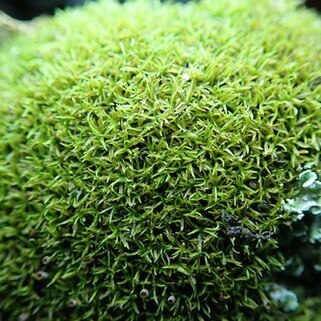Plants small to medium-sized, yellowish green to green above, brown below; saxicolous. Stems up to 38 mm tall, branching by subperichaetial innovations, scarcely tomentose below; rhizoids red-brown, smooth to papillose; in section subround to subtriangular, inner cortex 5-10 cells across, thin-walled or ± incrassate, outer cortical cells smaller, in 1 or 2 rows, incrassate, papillose. Leaves ± crowded, ± equal in size, erect and crisped when dry, erect-spreading and flexuose when wet; narrowly oblong-lanceolate to linear-lanceolate, 1.0-3.3 mm long; apex acute to acuminate, frequently with a single apical tooth; margins plane above, recurved below, entire, rarely decurrent. Costa ending below apex; ventral and dorsal superficial cells narrowly rectangular; in section subround or crescent-shaped, bulging dorsally, ventrally flat, laminal insertion ventral, guide cells in one layer medially, ventral substereids or stereids in one layer, papillose, dorsal substereids or stereids in 1 or 2 rows, papillose. Upper laminal cells irregularly rounded, incrassate, ± flat, papillose, weakly striolate, 8.7-15.0 µm, papillae ± low, blunt, scattered over dorsal and ventral surface; basal cells rectangular, thin-walled to incrassate, smooth to striolate. Autoicous. Perigonia terminal on short, subperichaetial branches; inner leaves ovate-apiculate or ovate-acuminate. Perichaetia terminal, frequently overgrown by subperichaetial innovations; leaves differentiated, sheathing, oval or oblong, 1.2-2.0 mm long, apex abruptly apiculate or acuminate, costa ending below apex, upper laminal cells irregularly rectangular or rhomboidal to vermiculate, incrassate, striolate. Seta short, 0.4-0.6 mm long, yellowish to brown. Capsule erect, immersed to shortly exserted, shortly pyriform or urceolate, brownish, urn 0.5-0.7 mm long, neck 0.3-0.6 mm long; exothecial cells irregularly rhomboidal to rectangular, incrassate, in 2-5 transverse rows at mouth, smaller at mouth; stomata present at base of urn and on neck. Operculum conic-rostellate, beak turned to one side. Calyptra 1 mm long, cells papillose. Spores 11-14 µm.
More
Plants 0.5-3.5 cm. Stem leaves ligulate-lanceolate, 2-3 mm; margins plane, entire; basal laminal cells clear, walls firm; distal cells 8-11 µm, obscured by papillae, papillae warty, relatively large. Sexual condition autoicous; perichaetial leaves erect, enlarged, base sheathing, apex short-pointed. Seta 1-1.5 mm. Capsule immersed to 1/2 emergent, 0.8-1.3 mm; operculum short-rostrate, less than diam. of capsule. Spores 9-13 µm.

